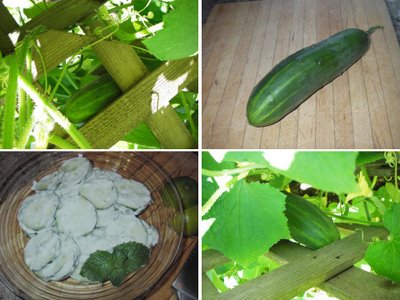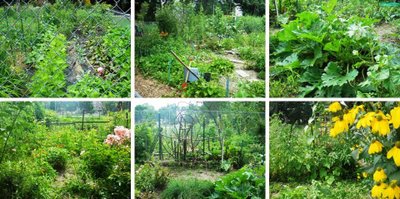 This tomato was delicious! I put the dates of the pictures in the lower right corner. (Click on the picture to enlarge it.) The flower bloomed on June 22. About 40 days from flower to ripe tomato.
This tomato was delicious! I put the dates of the pictures in the lower right corner. (Click on the picture to enlarge it.) The flower bloomed on June 22. About 40 days from flower to ripe tomato.Solanum lycopersicum
This is a journal of my vegetable gardens. Skippy was my first dog and he thought the garden was his, even though I did all the work. Now Suzie and Charley follow in his footsteps. We're located near Boston (USDA zone 6A). I have a community plot, a backyard vegetable garden, fruit trees, berry bushes, chickens, and bees. I use sustainable organic methods and do my best to grow all of my family's vegetables myself.

 This one is on Walden St, Cambridge, MA. Seems like fairly large plots. An enormous green-eyes Rudbeckia (8 ft!) in the northeast corner. Many flowers: especially black-eyed Susan, zinnias, cosmos, nasturtiums, daylilies. A stick sculpture in the center is an interesting focal point. Several chairs and benches are nice additions. Very happy plants. Sooo hot and humid today you can see the air in some pictures.
This one is on Walden St, Cambridge, MA. Seems like fairly large plots. An enormous green-eyes Rudbeckia (8 ft!) in the northeast corner. Many flowers: especially black-eyed Susan, zinnias, cosmos, nasturtiums, daylilies. A stick sculpture in the center is an interesting focal point. Several chairs and benches are nice additions. Very happy plants. Sooo hot and humid today you can see the air in some pictures.
 Today I caught up on alot of gardening work: Finally planted those colorful annuals I bought on Tuesday, trimmed off alot of seed pods and dead growth from the spring flowering plants, especially the lady's mantle. I fertilized all the vegetables well with Garden-Tone (4-6-6), adding super phosphate (0-20-0) to the fruiting and flowering plants. A special tomato formula for the tomatoes (4-7-10), plus I added extra phosphate hoping to encourage extra blooming and fruiting. The roses got a special formula too (Rose-tone, 6-6-4). Also I put Sevin on the squash and cuke stems (lowest 5 inches)(I know, not good ....). I checked the eggplants for stem-sucking bugs - one little one that I squished. By then the day was pretty hot (90 today in Boston) so I took a break.
Today I caught up on alot of gardening work: Finally planted those colorful annuals I bought on Tuesday, trimmed off alot of seed pods and dead growth from the spring flowering plants, especially the lady's mantle. I fertilized all the vegetables well with Garden-Tone (4-6-6), adding super phosphate (0-20-0) to the fruiting and flowering plants. A special tomato formula for the tomatoes (4-7-10), plus I added extra phosphate hoping to encourage extra blooming and fruiting. The roses got a special formula too (Rose-tone, 6-6-4). Also I put Sevin on the squash and cuke stems (lowest 5 inches)(I know, not good ....). I checked the eggplants for stem-sucking bugs - one little one that I squished. By then the day was pretty hot (90 today in Boston) so I took a break. I went by this community garden yesterday and couldn't resist stopping for a few pictures. Someone has an impressive crop of lettuce and peppers. Some nice sunflowers. Red bee balm. Squash vines are popular on the fence and have grown well out of the official garden area. (I should have checked for female squash flowers!) Something about community gardens is very pretty. And interesting. Different styles all together. Some plots weedy, some tended. Some in rows, others scattered. A patchwork.
I went by this community garden yesterday and couldn't resist stopping for a few pictures. Someone has an impressive crop of lettuce and peppers. Some nice sunflowers. Red bee balm. Squash vines are popular on the fence and have grown well out of the official garden area. (I should have checked for female squash flowers!) Something about community gardens is very pretty. And interesting. Different styles all together. Some plots weedy, some tended. Some in rows, others scattered. A patchwork.


 Well, this is my pea harvest for the year. Three packages of pea seeds. A mix of snap and snow peas. My peas just didn't sprout well and they grew slowly. Same as in previous years. It was suggested I add innoculum, which I will try next year if I don't give up on peas. The lettuce is a much better use of space for us. By the way, I steamed the peas (5 min) and served them with fancy French sea salt. Very tasty.
Well, this is my pea harvest for the year. Three packages of pea seeds. A mix of snap and snow peas. My peas just didn't sprout well and they grew slowly. Same as in previous years. It was suggested I add innoculum, which I will try next year if I don't give up on peas. The lettuce is a much better use of space for us. By the way, I steamed the peas (5 min) and served them with fancy French sea salt. Very tasty.



 I'm pleased with the way the eggplants look. After removing the 3 treehopper nymphs and a quick spray with nasty stuff (Sevin), they seem to be doing well. Some fruits are beginnning to form. Many blossoms. The 2 plants girdled by the treehoppers lost all their original leaves, but have many little new leaves coming and even those plants, though small, look sort of OK now. I check closely for more hoppers, but haven't found any more. I'm keeping my fingers crossed.
I'm pleased with the way the eggplants look. After removing the 3 treehopper nymphs and a quick spray with nasty stuff (Sevin), they seem to be doing well. Some fruits are beginnning to form. Many blossoms. The 2 plants girdled by the treehoppers lost all their original leaves, but have many little new leaves coming and even those plants, though small, look sort of OK now. I check closely for more hoppers, but haven't found any more. I'm keeping my fingers crossed.






 I found a large pot I hadn't filled yet this year in the back of the garage, so I got a 6-pack of pumpkins and an unlabeled (mystery!) 6-pack and planted them in it. I used three bamboo poles as a support and found a patch of unoccupied sun in the driveway. All I have to do is remember to water it and try not to back the car into it.
I found a large pot I hadn't filled yet this year in the back of the garage, so I got a 6-pack of pumpkins and an unlabeled (mystery!) 6-pack and planted them in it. I used three bamboo poles as a support and found a patch of unoccupied sun in the driveway. All I have to do is remember to water it and try not to back the car into it.



 This pretty blue flower is a really bad problem in my garden. This year I have let it go and it has flowered both in my side and front yard. Tempting to leave it, as the flowers are very nice. But it is horribly invasive and impossible to eliminate. I keep after it, sifting out the roots, and usually keep it in check. I'll probably be in trouble next year for letting it go this year. It crowds out everything else. Here's what some web sites have to say about it: "Creeping Bellflower (Campanula rapunculoides) is a native of Europe and was introduced to North America for its ornamental value. The root system of Creeping Bellflower is specially designed for long-term survival and persistence in cultivated conditions. Areas where it is moist and shady, this weed can become very invasive." "Creeping bellflower has escaped from older gardens to become a weed. It is a perennial, 2 to 4 feet tall, and spreads by deep roots. Leaves are somewhat rough and lance-shaped, tapering to a point. The 1-inch flowers are purple, down-turned and bell shaped. It can become a serious weed problem in urban areas as well as in pastures and open fields."http://www.sfn.saskatoon.sk.ca/science/splep/creeping_bellflower.html
This pretty blue flower is a really bad problem in my garden. This year I have let it go and it has flowered both in my side and front yard. Tempting to leave it, as the flowers are very nice. But it is horribly invasive and impossible to eliminate. I keep after it, sifting out the roots, and usually keep it in check. I'll probably be in trouble next year for letting it go this year. It crowds out everything else. Here's what some web sites have to say about it: "Creeping Bellflower (Campanula rapunculoides) is a native of Europe and was introduced to North America for its ornamental value. The root system of Creeping Bellflower is specially designed for long-term survival and persistence in cultivated conditions. Areas where it is moist and shady, this weed can become very invasive." "Creeping bellflower has escaped from older gardens to become a weed. It is a perennial, 2 to 4 feet tall, and spreads by deep roots. Leaves are somewhat rough and lance-shaped, tapering to a point. The 1-inch flowers are purple, down-turned and bell shaped. It can become a serious weed problem in urban areas as well as in pastures and open fields."http://www.sfn.saskatoon.sk.ca/science/splep/creeping_bellflower.html

